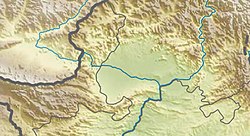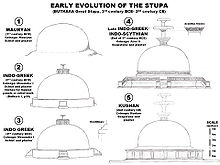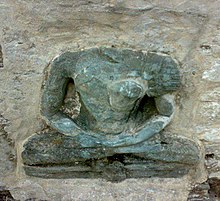| بت کړہ سټوپا | |
 Remains of the Butkara Stupa Remains of the Butkara Stupa | |
  | |
| Location | Swat Khyber Pakhtunkhwa Pakistan |
|---|---|
| Coordinates | 34°45′26″N 72°21′44″E / 34.7571°N 72.3622°E / 34.7571; 72.3622 |
| Type | Buddhist stupa |
| History | |
| Founded | 2nd century BCE |
| Periods | Gandhara |
The Butkara Stupa (Pashto: بت کړه سټوپا) is an important Buddhist stupa near Mingora, in the area of Swat, Pakistan. It may have been built by the Mauryan emperor Ashoka, but it is generally dated slightly later to the 2nd century BCE.
The stupa was enlarged on five occasions during the following centuries, every time by building over, and encapsulating, the previous structure.
Excavation

The stupa was excavated by an Italian mission (IsIOAO: Istituto Italiano per l'Africa e l'Oriente), led by archaeologist Domenico Faccenna from 1956, to clarify the various steps of the construction and enlargements. The mission established that the stupa was "monumentalized" by the addition of Hellenistic architectural decorations during the 2nd century BCE, suggesting a direct involvement of the Indo-Greeks, rulers of northwestern India during that period, in the development of Greco-Buddhist architecture.
An Indo-Corinthian capital representing a Buddhist devotee within foliage has been found which had a reliquary and a coin of Azes II buried at its base, securely dating the sculpture to earlier than 20 BCE.
The nearby Hellenistic fortifications of Barikot are also thought to be contemporary.
A large quantity of the artifacts are preserved in the National Museum of Oriental Art and the City Museum of Ancient Oriental Art in Turin (M.A.O.).
-
Ruins of Butkara I.
-
 Indo-Scythian devotee, Butkara I.
Indo-Scythian devotee, Butkara I.
-
 Indo-Corinthian capital representing a Buddhist devotee wearing a Greek cloak (chlamys) with fibula. Butkara Stupa, National Museum of Oriental Art, Rome.
Indo-Corinthian capital representing a Buddhist devotee wearing a Greek cloak (chlamys) with fibula. Butkara Stupa, National Museum of Oriental Art, Rome.
-
 The Indo-Corinthian capital from Butkara Stupa under which a coin of Azes II was found. Dated to 20 BCE or earlier (Turin City Museum of Ancient Art).
The Indo-Corinthian capital from Butkara Stupa under which a coin of Azes II was found. Dated to 20 BCE or earlier (Turin City Museum of Ancient Art).
Coinage and datation
The oldest core strata (GSt 1) revealed a coin of Chandragupta Maurya and is therefore dated to the Ashokan period. A coin of Menander I was found in the second oldest stratum (GSt 2). A coin of Azes II was found under a plinth of the third stratum (GSt 3), which is therefore dated to the end of the 1st century BCE or the beginning of the 1st century CE. The 4th stratum (GSt 4) contained late coins of Azes II and coins of the Kushan Kujula Kadphises.
Seated Buddha statue

The in-situ seated Buddha (or Bodhisattva) statue at Butkara is considered one of the earliest, if not the earliest, known iconographical statues of the Buddha in northwestern India. Van Lohuizen-de Leeuw considers that the statue dates to the late 1st century BCE to the early 1st century, as it was discovered in the GSt 3 stratum that contained a coins of Azes II. More conservative estimates date it to the 1st-2nd century CE, roughly at the same time the first known statues of the Buddha were made in the art of Mathura. Probably the earliest known statue of the Buddha in the art of Mathura is the "Isapur Buddha", dated to circa 15 CE. This would make the creation of the Buddha image an approximately simultaneous phenomenon between the two geographical areas.
Gallery
-
Head of the Buddha. Butkara I, 2nd century CE
-
Buddhist relief with warrior. Butkara I, 1st century CE.
-
 Statue at the site
Statue at the site
-
 Alchon Hun devotee, Butkara I (construction phase 4), 5th century CE.
Alchon Hun devotee, Butkara I (construction phase 4), 5th century CE.
See also
Notes
- "De l'Indus a l'Oxus: archaeologie de l'Asie Centrale", Pierfrancesco Callieri, p212: "The diffusion, from the second century BCE, of Hellenistic influences in the architecture of Swat is also attested by the archaeological searches at the sanctuary of Butkara I, which saw its stupa "monumentalized" at that exact time by basal elements and decorative alcoves derived from Hellenistic architecture".
- The Turin City Museum of Ancient Art Text and photographic reference: Terre Lontane > O2 Archived 12 December 2006 at the Wayback Machine
- ^ Handbuch der Orientalistik, Kurt A. Behrendt, BRILL, 2004, p.49 sig
- ^ Rhi, Ju-Hyung (1994). "From Bodhisattva to Buddha: The Beginning of Iconic Representation in Buddhist Art". Artibus Asiae. 54 (3/4): 220, Fig.12. doi:10.2307/3250056. JSTOR 3250056.
- Quintanilla, Sonya Rhie (2007). History of Early Stone Sculpture at Mathura: Ca. 150 BCE - 100 CE. BRILL. pp. 199–206, 204 for the exact date. ISBN 9789004155374.
- de la Vaissiere, Etienne (2007). "A Note on the Schøyen Copper Scroll: Bactrian or Indian?" (PDF). Bulletin of the Asia Institute. 21: 127. JSTOR i24047314. Retrieved 8 July 2018.
References
- Report of the Italian Archaeological Mission (Pdf, Italian)
- Domenico Faccenna, Butkara I (Swat, Pakistan), 1956–1962, Roma, 1962-1981
External links
- Other capitals from Butkara I in Srinivasan, D.M. (2007). On The Cusp Of An Era Art In The Pre Kuṣāṇa World. BRILL. pp. Fig. 7.18 and 7.19.
This Buddhism-related article is a stub. You can help Misplaced Pages by expanding it. |